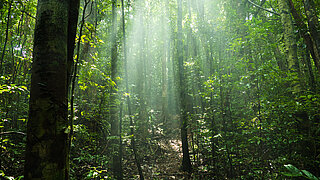The REDD+ framework

Intact forests for climate change mitigation
The basic idea of the REDD+ framework consists of providing emerging market and developing economies with financial incentives to demonstrably reduce deforestation and forest degradation. The approach comprises three phases:
Phase 1: Readiness
Nations develop national REDD+ strategies, and specify a reference value based on rates of deforestation and current forest stocks. This enables the development of forested areas to be compared with areas in the past, making this development measurable. The difference in the two values also enables calculations of forest retention and the volume of greenhouse gas emissions that have been avoided as a result.
Phase 2: Implementation
Countries implement the agreed measures, reduce deforestation and use pilot projects to investigate how REDD+ can be used to avoid emissions. The corresponding IKI projects provide important insights into best practices for protecting forests without conflict and ensuring that REDD+ payments are fairly distributed to all participating groups.
Phase 3: Payments for results
Nations are compensated retroactively for proven reductions in emissions. Payments can also be made if the country has achieved progress in implementing reforms in its forestry sector. Payments are forwarded to participating actors using a profit distribution system. The Green Climate Fund (GCF) in particular has a key role to play in REDD+ financing.
Safeguards and additional benefits of carbon sequestration
Internationally, the conservation of biodiversity is viewed as an important additional benefit provided by REDD+. To increase these kinds of ‘co-benefits’, appropriate criteria should be integrated into the REDD+ strategies.
At the same time, social and environmental safeguards must also be applied in order to prevent any negative consequences resulting from REDD+ measures. Protecting the rights and participation of local populations and indigenous peoples is an important goal here. IKI accordingly supports projects that develop, implement and monitor such projects and therefore promote co-benefits.
IKI’s role in establishing the REDD+ framework
IKI has helped to shape and influence the design of the international REDD+ framework by providing partner countries with support in developing and applying solutions for implementing REDD+ strategies (Phase 2). This has ensured the creation of a results-based REDD+ system.
IKI projects address a broad spectrum of instruments. From pilot projects to establishing technical know-how and institutional structures, advising governments and providing technical expertise, project work also ensures the effective use of investment in the forestry sector while promoting the exchange of knowledge and experience.
Selected projects
Funding area

The link has been copied to the clipboard


